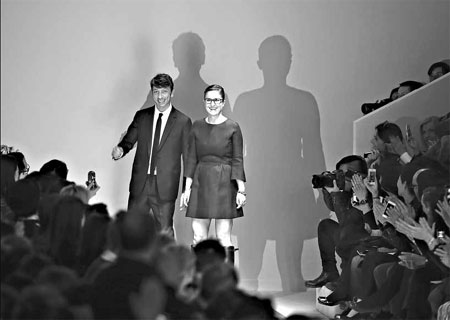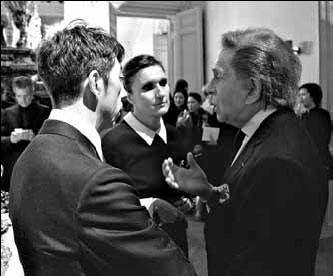Designers put own stamp on Valentino's fashions
Updated: 2013-03-24 07:58
By Eric Wilson(The New York Times)
|
|||||||
|
With their ready-to-wear collection, Pierpaolo Piccioli and Maria Grazia Chiuri have come into their own. Thibault Camus / Associated Press |
|
The fashion icon Valentino Garavani, near left, with his successors, Pierpaolo Piccioli, far left, and Maria Grazia Chiuri. Valerio Mezzanotti for The New York Times |
PARIS - The setting was a reception hall in the Salomon de Rothschild mansion. In front of a lavish table setting were the designers who took over the Valentino label in late 2008: Maria Grazia Chiuri and Pierpaolo Piccioli.
Their Fashion Week party here on March 5 marked the reopening of the Valentino store on Avenue Montaigne, which had been overhauled to reflect their vision of the label.
To one side was Valentino Garavani, with his business partner, Giancarlo Giammetti, the men who made Valentino a household name. The guests complimented the designers on their fall collection inspired by the paintings of Flemish masters.
"They get better every season," Elisabeth von Thurn und Taxis, Vogue's style editor at large, said of Ms. Chiuri and Mr. Piccioli. "But it must be hard to work with a living legend."
Mr. Garavani, 80, has remained in the spotlight since his retirement in 2008. That year, the documentary "Valentino: The Last Emperor" made him a celebrity for a new generation.
Recently, Mr. Garavani and Mr. Giammetti attended every major party in Los Angeles on the Oscars circuit, at the same time that the company was trying to lure celebrities with red-carpet dresses designed by Ms. Chiuri and Mr. Piccioli. (There were two successes, with Sally Field and Jennifer Aniston, and one embarrassment, with Anne Hathaway.)
When they took over the collection, Ms. Chiuri and Mr. Piccioli were described as "very Valentino." Having designed accessories for Valentino for a decade, they knew the codes of his house. Alessandra Facchinetti, a former Gucci designer, had succeeded Mr. Garavani, but was fired after going too far in her own direction.
Replacing any designer is like walking a tightrope; replacing Mr. Garavani is like walking on a thread. Ms. Chiuri and Mr. Piccioli have managed to do that better than anyone might have imagined. Their most recent collections have included designs that are often regal and conservative in appearance - like church dresses, with high collars, but with lively filigree or floral lace patterns - and they are now coming into their own. The designs look nothing like the Valentino of old, and no one has complained.
The March 5 show included a Delftware-inspired dress made of five meters of fabric, each meter requiring 28 hours of handwork as the designers try to bring a couture sensibility to their ready-to-wear. "It is wonderful what they are doing," Mr. Garavani said. "This is how the future of Valentino can be modern."
Ms. Chiuri and Mr. Piccioli are, as Cathy Horyn, the fashion critic of The New York Times, wrote of their spring couture show, "more self-critical and demanding."
And they have no complaints about Mr. Garavani's enduring public profile at Valentino, which was acquired in July by Mayhoola, an investor group from Qatar. His presence serves a purpose. "We love fashion more than we love the lifestyle of fashion," Mr. Piccioli said.
Ms. Chiuri, 49, and Mr. Piccioli, 45, trace their friendship to the late 1980s in Florence, Italy, when the city was a lively center of international fashion. When Ms. Chiuri was offered a job at Fendi, she asked Mr. Piccioli to join her. More than 20 years later, they describe themselves as "like an old couple." They often dress alike, but each has a family life and a spouse, Ms. Chiuri with two children and Mr. Piccioli with three.
"We are two designers," Ms. Chiuri said. "And how we work is very specific."
In Rome, they share an office with two desks and two computers facing each other, and only one phone. Internally, they are referred to as MGPP. They have a hard time saying no to each other's ideas. Women's Wear Daily wrote that their fall show "would not have suffered from a few less looks, gorgeous as they all were."
Valentino's sales, $510 million in 2012, have improved, and there is a revitalized men's wear business. "We are not trying to make fashion in the traditional way," said Stefano Sassi, the chief executive. "We should be more iconic, not just because of the red or the evening gowns, but because of this kind of statement, too."
Still, Valentino would not be Valentino without the glamour.
The dinner in Paris included Ms. Hathaway, a longtime member of the Valentino "family" whose last-moment switch to a Prada dress at the Oscars offended some. Oddly, Ms. Chiuri and Mr. Piccioli, who designed the rejected dress, supported her decision. "What we try to say as designers is that beauty is how you feel in the moment," Mr. Piccioli said. "Respecting women means respecting their choices."
The New York Times
(China Daily 03/24/2013 page12)

